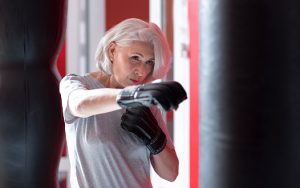 High-intensity aerobic exercise has been found to reverse some aspects of aging at the cellular level in those 65 and older. Researchers from the Mayo Clinic compared the effects of high-intensity interval training, resistance training, and combined training in adults 65 and older and found that while all forms of exercise improved lean body mass and insulin sensitivity, only high-intensity interval training and combined training were able to improve aerobic capacity as well as reverse cellular aspects of aging.
High-intensity aerobic exercise has been found to reverse some aspects of aging at the cellular level in those 65 and older. Researchers from the Mayo Clinic compared the effects of high-intensity interval training, resistance training, and combined training in adults 65 and older and found that while all forms of exercise improved lean body mass and insulin sensitivity, only high-intensity interval training and combined training were able to improve aerobic capacity as well as reverse cellular aspects of aging.
The decline in mitochondrial content and function is common in older adults and occurs as we age, affecting muscle mass and function. High-intensity interval training was shown to improve muscle protein content and enhance energetic function while also aiding in the accumulation of muscle mass in older adults. The research team highlighted that exercise can significantly enhance the cellular machinery that is responsible for producing new proteins, which in turn aids in protein synthesis and can reverse the adverse effects of aging on the body.
Advertisement
Dr. K. Sreekumaran Nair, the senior researcher of the study, explained: “We encourage everyone to exercise regularly, but the take-home message for aging adults is that supervised high-intensity training is probably best, because, both metabolically and at the molecular level, it confers the most benefits.” This high-intensity exercise was found to reverse some of the effects of aging on the body’s protein function, though resistance training was also highlighted as an important means for adding muscle strength.
The aim of this study was to help researchers develop targeted therapies for older adults that would prevent or improve the muscle loss that occurs with aging. The results found that cardiorespiratory health, muscle mass, and insulin sensitivity was improved with all forms of training, emphasizing the importance of leading an active lifestyle as you age.
Related: Dementia risk lowered with aerobic exercise
